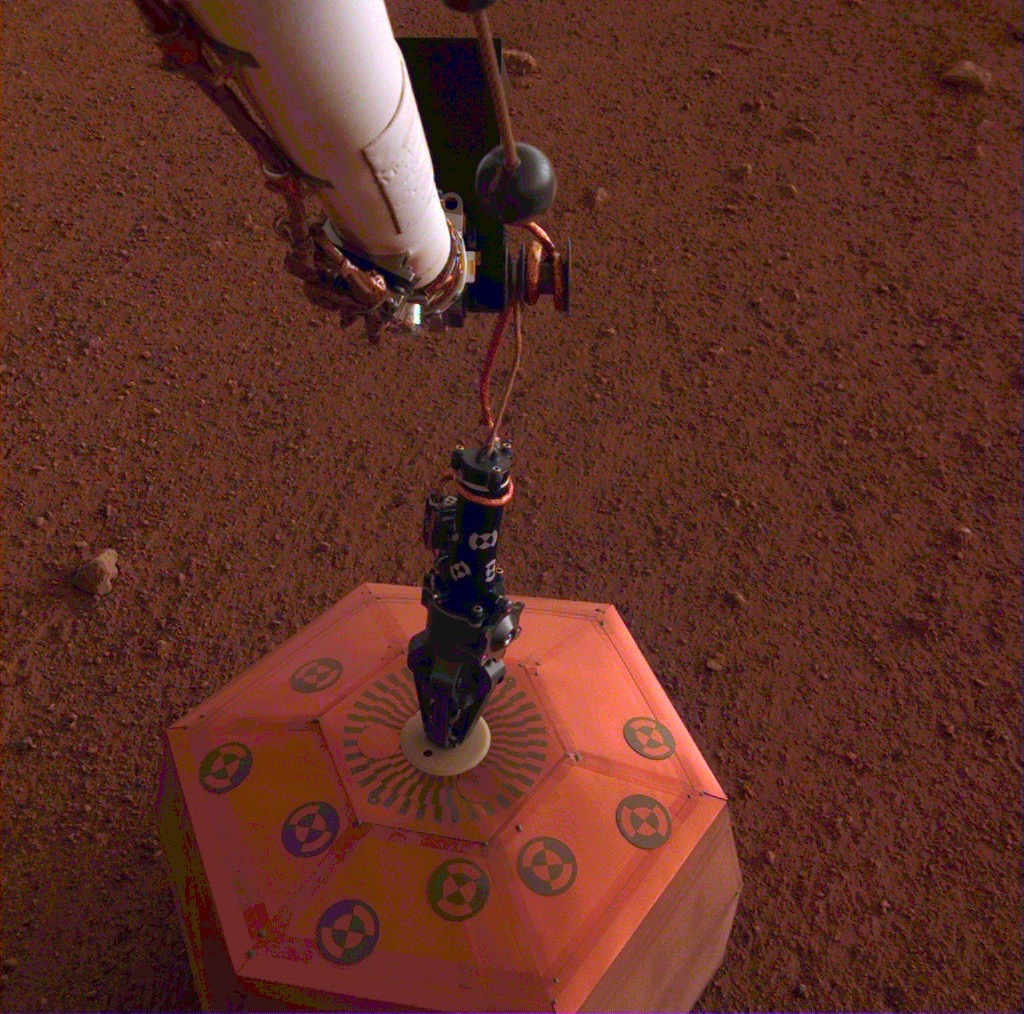NASA's InSight Lander Plops Seismometer on Mars to Hunt Marsquakes

For the first time ever, a robot has deployed a science instrument onto the surface on Mars.
NASA's InSight lander, which touched down on the Red Planet late last month, placed its supersensitive seismometer onto the red dirt yesterday (Dec. 19), agency officials announced.
That's surprisingly soon; just after landing, mission team members had estimated that they wouldn't be ready to start instrument deployment for two to three months. [Mars InSight in Photos: NASA's Mission to Probe Core of the Red Planet]
"InSight's timetable of activities on Mars has gone better than we hoped," InSight project manager Tom Hoffman, who's based at NASA's Jet Propulsion Laboratory (JPL) in Pasadena, California, said in a statement. "Getting the seismometer safely on the ground is an awesome Christmas present."
The $850 million InSight mission aims to map the interior of Mars in unprecedented detail, to shed light on the formation and evolution of rocky planets. The lander will do this work using two primary science instruments — the seismometer, known as the Seismic Experiment for Interior Structure (SEIS), and a burrowing tool called the Heat Flow and Physical Properties Probe (HP3). A key goal for the seismometer is detecting Marsquakes to understand how they work.
Mars rovers and landers typically carry their science instruments on their bodies, or at the ends of their flexible robotic arms. But InSight is different; both SEIS and HP3 must sit directly on the Martian surface to do their work.
Yesterday's activity therefore marked a huge milestone for the mission.
Get the Space.com Newsletter
Breaking space news, the latest updates on rocket launches, skywatching events and more!
"Seismometer deployment is as important as landing InSight on Mars," mission principal investigator Bruce Banerdt, also of JPL, said in the same statement. "The seismometer is the highest-priority instrument on InSight: We need it in order to complete about three-quarters of our science objectives."
Team members carefully analyzed the area around the lander's legs, looking for the best place to put SEIS down. And they practiced deployment — which is done with the claw-like grapple on the end of InSight's 5.75-foot-long (1.8 meters) robotic arm — using a testbed lander at JPL known as ForeSight.
The InSight team beamed deploy commands to the lander on Tuesday (Dec. 18), and yesterday the lander pulled off the job. InSight put SEIS down directly in front of itself, about as far away as its arm could reach — 5.367 feet (1.636 m), NASA officials said.
SEIS now sits on a slope measuring 2 to 3 degrees. The InSight team will try to level SEIS, after which the instrument will start hunting for seismic waves coursing through the Martian subsurface.
"Having the seismometer on the ground is like holding a phone up to your ear," said SEIS principal investigator Philippe Lognonné, from Institut de Physique du Globe de Paris (IPGP) and Paris Diderot University. "We're thrilled that we're now in the best position to listen to all the seismic waves from below Mars' surface and from its deep interior."
The first few weeks of SEIS operation will be devoted to instrument checkouts. The team plans to place a wind and thermal shield over SEIS in early January, to dampen environmental noise that could interfere with the instrument's readings, NASA officials said.
HP3 deployment will probably occur in late January. The heat probe will be put down on the east side of the lander's "work space," about the same distance from InSight as SEIS is, mission team members said.
InSight, whose name is short for "Interior Exploration using Seismic Investigations, Geodesy and Heat Transport," will operate for at least one Martian year, or nearly two Earth years. During this time, the mission team will also precisely track InSight's location using the lander's communication gear. This work will reveal how much Mars is wobbling on its axis, information that should help scientists better understand the planet's core.
Mike Wall's book about the search for alien life, "Out There" (Grand Central Publishing, 2018; illustrated by Karl Tate) is out now. Follow him on Twitter @michaeldwall. Follow us @Spacedotcom or Facebook. Originally published on Space.com.
Join our Space Forums to keep talking space on the latest missions, night sky and more! And if you have a news tip, correction or comment, let us know at: community@space.com.

Michael Wall is a Senior Space Writer with Space.com and joined the team in 2010. He primarily covers exoplanets, spaceflight and military space, but has been known to dabble in the space art beat. His book about the search for alien life, "Out There," was published on Nov. 13, 2018. Before becoming a science writer, Michael worked as a herpetologist and wildlife biologist. He has a Ph.D. in evolutionary biology from the University of Sydney, Australia, a bachelor's degree from the University of Arizona, and a graduate certificate in science writing from the University of California, Santa Cruz. To find out what his latest project is, you can follow Michael on Twitter.









